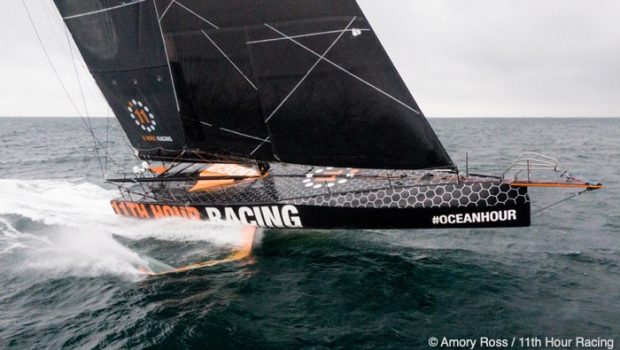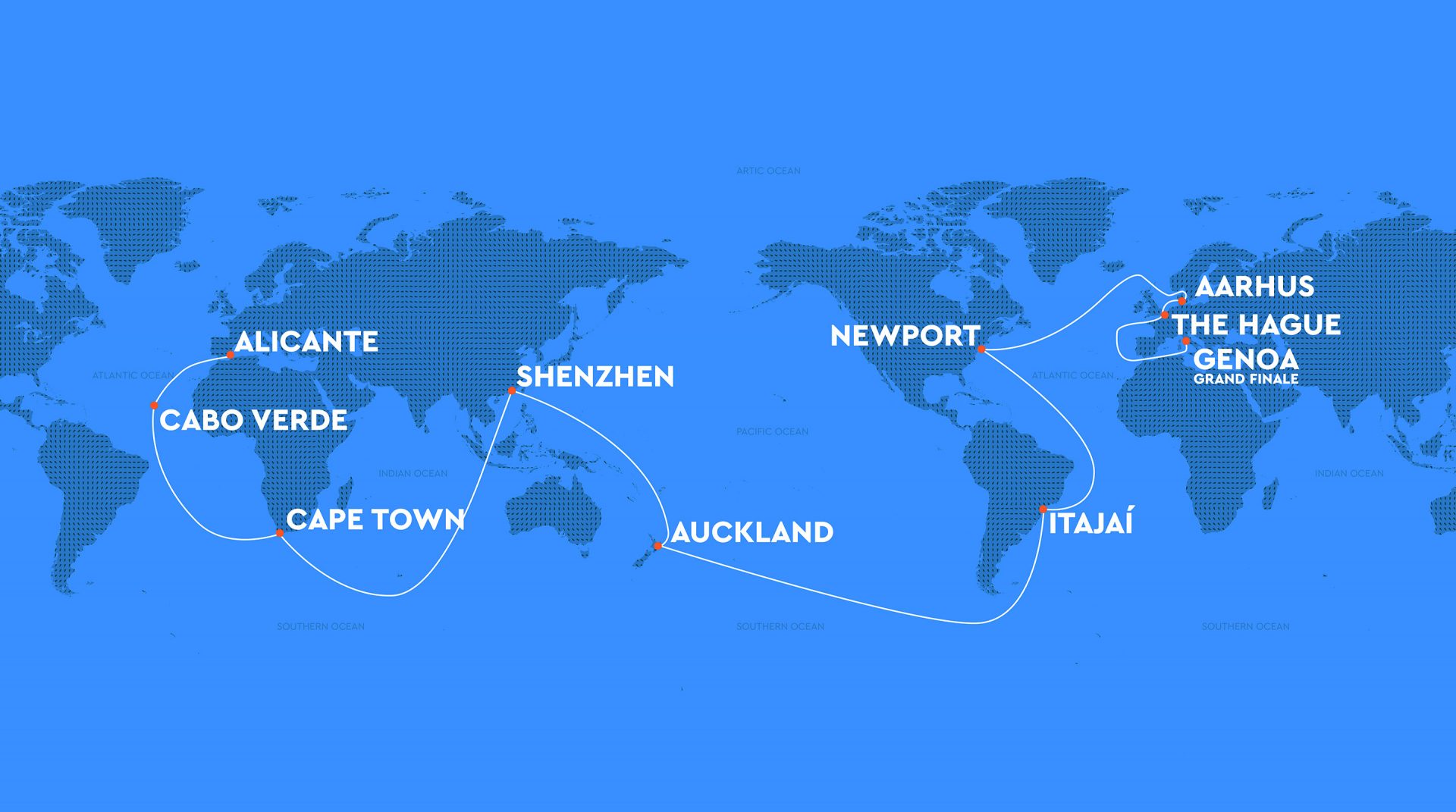11th Hour Racing Team adds to roster
Published on July 31st, 2020
Newport, RI (July 31, 2020) – 11th Hour Racing Team announced the addition of several high-profile sailors to its training crew with five-time Ocean Race veteran Simon Fisher (UK) joining the team in France, along with past America’s Cup and SailGP winner Kyle Langford (AUS) and 2017-18 Ocean Race participant Emily Nagel (Bermuda).
The trio has come together in Brittany with Skipper Charlie Enright, onboard reporter Amory Ross and Justin Shaffer, who oversees special projects, to prepare for the team’s upcoming transatlantic. The departure from Concarneau, France to Newport, Rhode Island, is scheduled for August 1st as 11th Hour Racing Team kicks off its two-year preparation plan for the next edition of The Ocean Race in 2022-2023.
Veteran offshore racer Simon Fisher, also known within the sport as SiFi, was a Volvo Ocean Race trophy winner in 2014-15 as navigator of Abu Dhabi Ocean Racing and sailed alongside Enright and Towill in the 2017-18 Volvo Ocean Race with Vestas 11th Hour Racing. Originally from Essex, UK, he is now based out of Spain and southern England.
Kyle Langford, from Australia, sailed every offshore leg with third-place finisher Team Brunel from the Netherlands in the 2017-18 Volvo Ocean Race. Prior to that he was a member of Oracle Team USA in the 2017 America’s Cup, after winning the 2013 America’s Cup with Oracle. In 2019, Langford captured the inaugural SailGP title with Australia SailGP Team as wing trimmer, and more recently has been on the podium at the International Moth World Championships. When not racing, he makes his home in Stockholm, Sweden.
Emily Nagel is a trained naval architect who had her first taste of The Ocean Race in 2017-18 as part of Team AkzoNobel. Hailing from Bermuda, Nagel has worked for America’s Cup teams and SailGP on the technical and design side and has also represented Great Britain at European and World Championship sailing events. She currently resides in Weymouth, UK, where she campaigns her foiling moth in her spare time.
With oversight of special projects, Shaffer specifically focuses on technology, fiber optics and performance analysis for 11th Hour Racing Team, while Ross handles the role of onboard reporter as videographer and photographer, a key role during the nine months of The Ocean Race.
“We have pulled together a wealth of experience and talent for this transatlantic,” said 11th Hour Racing Team Skipper Enright. “We are obviously itching to get miles and offshore training under our belts with the delays we’ve had this year. This is an experienced crew and a dynamic training group that brings together a broad range of skills as we look ahead to 2022.”
Langford, Ross and Enright were together for the team’s transatlantic sail from Brazil to France late last year. The addition of Fisher, Shaffer and Nagel creates a new mix of six sailors for this training in which the team will put to the test a next-generation wing foil and other new systems from the boat’s recent refit.
“We have built a foil with the latest generation of technology,” said Team CEO Mark Towill. “The new T-foil design basically does two things: it creates lift and and reduces leeway. During the transatlantic, we will be testing out the new rake system with different sail combinations.”
The current training boat is one of the first-generation IMOCA 60s to foil — meaning its hull can lift out of the water at high speeds. The new foil has been designed and refined using computer simulation tools. The latest IMOCA rule provides for a “second degree of freedom,” allowing foils the ability to rake backwards and forwards several degrees.
The team worked closely with performance partner MerConcept and Naval Architect Guillaume Verdier to develop the foil design and hopes to gain considerable insight over the next weeks of sailing. A second new foil will be installed later this fall.
“It’s very important to test these concepts in reality and validate the projected performance against actual data. This learning process is very important in our efforts to have the most competitive platform for The Ocean Race in two years time,” added Towill.
Once the team arrives in Rhode Island, the sailors will base themselves out of Newport for a fall season of offshore training, sea trials and on-land activations and sustainability initiatives.
“While the one year postponement of the race has changed our timelines, planning and the location of our training base for the short term, we think having the next few months in Newport gives us a great jumping off point to begin sailing and working together as a unit,” added Enright.
“Our emphasis is on training safely and testing new systems with the goal of putting the best and fastest possible team at the start line of The Ocean Race in Alicante, Spain in 2022.”
Each member of the training team will go through the team’s sustainability induction process highlighting the team’s parallel mission to win the next edition of The Ocean Race while making a commitment to sustainable operations and inspiring sailors and sports fans.
Non-sailing team events in Newport will include a team “Homecoming” to connect with fans during a socially-distant event and The Newport Ocean Summit, a virtual gathering of scientists, business leaders and policy-makers around the latest ocean health issues.
Team details: https://11thhourracingteam.org/
Event details – Route – Teams – Facebook
Here was the plan prior to the 2022-23 postponement:
The Ocean Race 2021-22 (formerly The Volvo Ocean Race) will be raced in two classes of boats: the high-performance, foiling, IMOCA 60 class and the one-design VO65 class which has been used for the last two editions of the race. Entries in the IMOCA 60 class will compete for The Ocean Race trophy, while those racing the VO65s will chase the Ocean Challenge Trophy.
Ten Stopovers for 14th Edition:
• Alicante, Spain: This historic Mediterranean port will host the start for the fifth consecutive edition in the autumn of 2021.
• Cabo Verde: More accustomed to having offshore teams sail by, or stop for repair, this archipelago of ten volcanic islands in the central Atlantic Ocean will become just the second African venue the race has ever visited and the first West African nation to host the event. Details.
• Cape Town, South Africa: Located on the shore of Table Bay, Cape Town, as the oldest urban area in South Africa, was developed by the United East India Company (VOC) as a supply station for Dutch ships sailing to East Africa, India, and the Far East. Located at latitude 33.55° S, it’s approximately the same as Sydney and Buenos Aires and equivalent to Casablanca and Los Angeles in the northern hemisphere. Details.
• Shenzhen, China: Located in the southeast, the city is a modern metropolis that links Hong Kong to China’s mainland. It’s known for its shopping destinations and features contemporary buildings, such as the 600m-tall skyscraper Ping An International Finance Centre, and a number of amusement parks. The city is a leading global technology hub and was one of the fastest-growing cities in the world in the 1990s and the 2000s. Details.
• Auckland, New Zealand: European, Polynesian, Asian, and strong Maori heritages give Auckland its distinctive culture. Located in the North Island of New Zealand, it is the most populous urban area in the country with an urban population of around 1,570,100. Details.
• Itajaí, Brazil: To the south of Rio de Janeiro, Itajaí was founded in the mid-19th century by German and Italian colonists, and is now the commercial centre and Atlantic port for an agricultural region drained by the Itajaí River and its tributaries. Details.
• Newport, USA: Located on Aquidneck Island, Newport is 74 miles south of Boston and 180 miles northeast of New York City. It is known as a New England summer resort and is famous for its historic mansions and its rich sailing history. It was the location of every challenge to the America’s Cup between 1930 and 1983. It is also the home of Naval Station Newport, which houses the United States Naval War College, the Naval Undersea Warfare Center, and an important Navy training center. This is the third consecutive edition of the race to stop in Newport. Details.
• Aarhus, Denmark: The course comes to the east coast of the Jutland peninsula during the spring of 2022, following a popular ‘Fly-By’ of the city during the final leg of the 2017-18 edition of the Race. Details.
• The Hague, Netherlands: This city along the North Sea coast will welcome the race for a third consecutive time, first coming as a ‘pitstop’ on the final leg of the 2014-15 edition and as the final finish port for the 2017-18 race. Details.
• Genoa, Italy: As the birthplace of Christopher Columbus, this first-time race host is Italy’s largest sea port yet remains full of grandeur as the gateway to the Riviera while offering weighty architectural heritage. Details.










 We’ll keep your information safe.
We’ll keep your information safe.